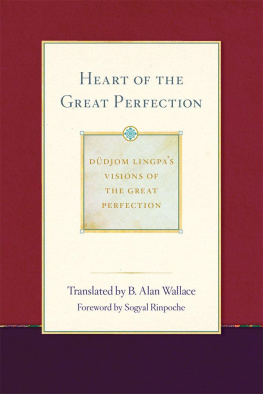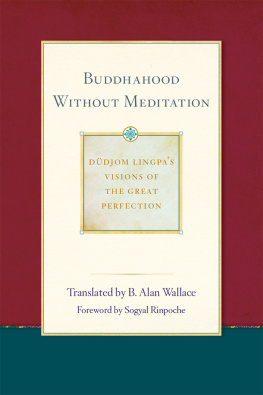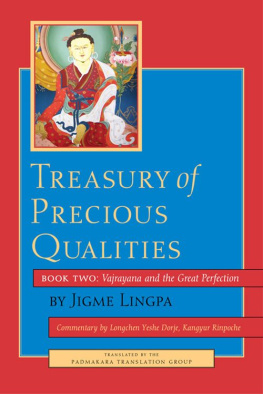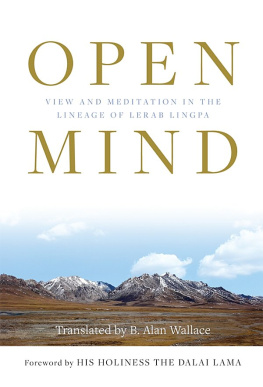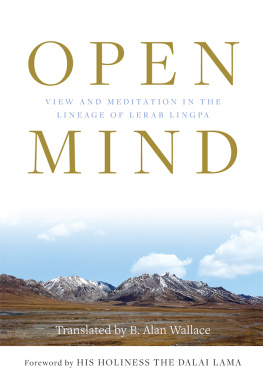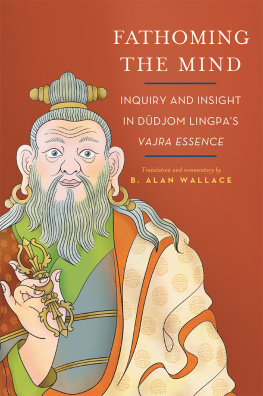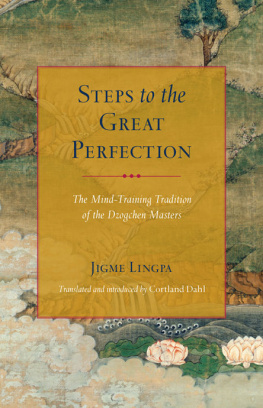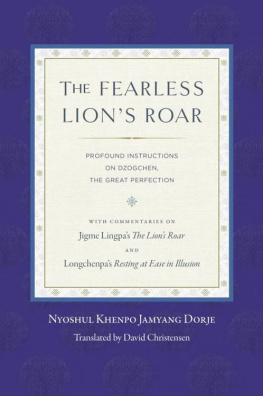D DJOM L INGPAS V ISIONS OF THE G REAT P ERFECTION
This three-volume series presents English translations of Ddjom Lingpas five visionary teachings on Dzokchen , the Great Perfection, along with three essential commentaries by his disciples.
V OLUME 1. H EART OF THE G REAT P ERFECTION
The Sharp Vajra of Conscious Awareness Tantra , Ddjom Lingpa
Essence of Clear Meaning , Pema Tashi
The Foolish Dharma of an Idiot Clothed in Mud and Feathers , Ddjom Lingpa
The Enlightened View of Samantabhadra , Ddjom Lingpa
V OLUME 2 . B UDDHAHOOD W ITHOUT M EDITATION
Buddhahood Without Meditation , Ddjom Lingpa
The Fine Path to Liberation , Sera Khandro
Garland for the Delight of the Fortunate , Sera Khandro
V OLUME 3 . T HE V AJRA E SSENCE
The Vajra Essence , Ddjom Lingpa

D DJOM L INGPA (18351904) was one of the foremost tantric masters of his time. His visionary teachings on the Great Perfection ( Dzokchen ) are the pinnacle of practice in Tibets oldest Buddhist school.
Heart of the Great Perfection , the first of three volumes devoted to the Dzokchen visions of Ddjom Lingpa, contains four of his classic works explaining the view and practice of this signature style of meditation.
The Sharp Vajra of Conscious Awareness Tantra: This work is considered the root distillation of Ddjom Lingpas wisdom.
Essence of Clear Meaning: This definitive commentary, which unpacks the quintessential verses of The Sharp Vajra, is based on Ddjom Lingpas oral teachings recorded by his disciple Pema Tashi.
The Foolish Dharma of an Idiot Clothed in Mud and Feathers: Ddjom Lingpa narrates the essential Dharma teachings from the perspective of an old man rejecting superficial appearances.
The Enlightened View of Samantabhadra: A masterful exposition of the Great Perfection is revealed as a dialogue between wisdom beings who bestow a treasury of pith instructions and specific advice for practitioners.
The teachings in these pages, which have inspired generations of Tibetans, are now available in English for the first time.
B. A LAN W ALLACE has served as the interpreter for both the Venerable Gyatrul Rinpoch and His Holiness the Dalai Lama. Today he is a prolific writer and translator of Tibetan Buddhism. He has edited, translated, authored, and contributed to many books including Stilling the Mind and The Attention Revolution.
Contents


Foreword

T WELVE HUNDRED YEARS AGO , one of the most dramatic and daring spiritual undertakings in history took place in Central Asia. The entire teaching of the Buddha, as it existed at the time in India and the Himalayan region, was imported and transplanted in Tibet. Sometimes I try to imagine what it must have been like to be there at that spectacular moment. To see the unforgettable, awe-inspiring figure of Guru Rinpoch, Padmasambhava, whose protection and inspiration enabled this whole revolutionary endeavor to unfold. To witness the great Madhyamaka scholar and abbot ntarakita, who brought with him the vast heritage of Nland Monastery, and the Tibetan king Trisong Detsen, the thirty-seventh in his line, who sponsored this massive and imaginative program. Or to gaze in wonder as Guru Rinpoch stood atop Mount Hepori and bound the spirits of Tibet under his command, and to watch the first monastic university, called Samy The Inconceivable, gradually take shape. If you had been there, you would have caught sight of scores of realized and learned paitas, who had made the arduous journey across the Himalayas and were working with translators to render the sutras, tantras, and treatises into Tibetan. Transmissions of various kinds were taking place, the first seven Tibetan monastics were being ordained, and Guru Padmasambhava was opening the maala of the Secret Mantrayna teachings at Chimpu for his twenty-five disciples. They were the first saints and siddhas of Tibet, headed by Guru Rinpochs closest disciple and consort, Yesh Tsogyal, the king himself, and the virtuoso translator Vairocana. What a glorious and momentous time this must have been! And although history tells us that this did not happen without opposition and resistance, both human and nonhuman, as Kyapj Ddjom Rinpoch explains, Because the kingdom was protected by the true Dharma, Tibet is known to have enjoyed the happiness of paradise.
For about fifty-five years, it is said, the Great Guru stayed in Tibet and the Himalayan regions, sowing his blessings into the environment and the psyche of the Tibetan people. Foreseeing the needs of future generations and the limits of peoples understanding at the time, Padmasambhava concealed countless terma treasure teachings in the landscape and in the unchanging pure awareness of his realized disciples. The terma teachings remain concealed until the precise moment in time when they will be of maximum benefit and relevance, and they are then revealed by a continuing series of incarnations of the same twenty-five disciples whom Padmasambhava had entrusted with his teachings and his blessings. As a result, the ancient Nyingma tradition of early translations that follows Padmasambhavas vision comprises both the long, unbroken kama lineage of canonical teachings and the close lineage of terma treasures. And at the heart of the Nyingma tradition flows the deepest current of wisdom within the Buddhist teachings of Tibet, the pinnacle of all spiritual vehicles the Great Perfection, Dzokpachenpo , with its living lineage of realization stretching from the Primordial Buddha Samantabhadra down to the present day.
One of Guru Rinpochs twenty-five disciples showed remarkable aptitude at a very early age. He learned Sanskrit with ease and was quickly chosen to be part of the group of Tibetan translators. Drokpen Khyeuchung Lotsawa lived as a ngakpa , a lay mantric practitioner, wearing his hair long and dressing in white. He mastered all the secret Mantrayna teachings Padmasambhava conferred on him and became a great siddha. His realization and power were such that he could summon birds from the sky through his mere gaze or a gesture of his hand, and then, it is said, give them teachings. Like others among the twenty-five disciples, Khyeuchung Lotsawa reincarnated over the centuries as a series of realized masters who spread and deepened the teachings of the Buddha and brought enormous benefit to beings. In the nineteenth century he appeared as the great treasure revealer, visionary, and powerful mystic Ddjom Lingpa.
I first came to learn about this amazing master after meeting his incarnation, Kyapj Ddjom Rinpoch, who became one of my most beloved teachers. I discovered that everything about Ddjom Lingpa was extraordinary: his birth in 1835 in the Serta Valley of the Golok region on Guru Rinpochs day, the tenth day of the waxing moon; his amazing life story, which was a continuous stream of visions, dreams, and prophecies starting at the age of three; the way in which he received visionary teachings of the greatest depth and clarity directly from enlightened beings of every kind; his mastery of earth termas, mind termas, and pure visions; the sheer profundity of his revelations, such as those contained in these volumes; his visits to pure lands, including Sukhvat and the Copper Colored Mountain paradise of Guru Rinpoch a visit that spanned one human day but for him lasted twelve years; and his continuous perception of enlightened beings and pure realms.
Next page
